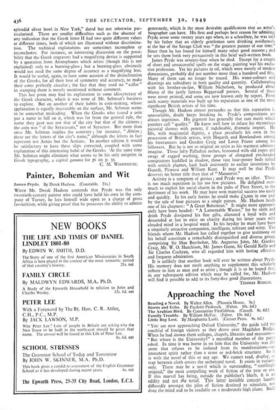Painter, Bohemian and Wit
James Pryde. By Derck Hudson. (Constable. 21s.)
WHEN Mr. Derek Hudson contends that Pryde was the only twentieth-century painter who could have held his own in the com- pany of Turner, he lays himself wide open to a charge of gross favouritism, while giving proof that he possesses the ability to admire generously, which is the most desirable qualification that an artist's biographer can have. His first and perhaps best reason for admiring Pryde arose some twenty years ago when, as a schoolboy, he was told by his father that an elderly gentleman seen drinking assiduously at the bar of the Savage Club was " the greatest painter of our time." Since then he has found for himself many other good reasons ; and
he sets them forth very persuasively in this brief well-written book.
James Pryde was seventy-four when he died. Except for a couple of short and unsuccessful spells on the stage, painting was his exclu- sive profession. Yet his pictures in oil, which were mostly of modest dimensions, probably did not number more than a hundred and fifty. Many of them can no longer be traced. His water-colours and drawings are subsidiary in both quality and quantity. Collaborating with his brother-in-law, William Nicholson, he produced about fifteen of the justly famous Beggarstaff posters. Several of these were never printed, and some are now known only by report. From such scanty materials was built up his reputation as one of the most significant British artists of his time.
Though Mr. Hudson almost persuades us that this reputation is unassailable, doubt keeps breaking in. Pryde's compositions are always ingenious. His pigment has generally that rare merit which painters call " quality." He knew well how to infuse his mysterious pictorial themes with potent, if indefinable, dramatic import. 11,1 fills, with magisterial dignity, a place peculiarly his own in the procession of British artists, with Hogarth and Rowlandson among his forerunners and Gordon Craig and Lovat Fraser among his followers. But he is not so original an artist as his warmest admirers imagine. Those lofty Palladian arches, festooned with old ropes and swags of ragged washing, those groups of elongated pin-headed conspirators huddled in shadow, those vast four-poster beds tufted with ostrich plumes, hark back insistently to earlier inventions by Guardi, Piranesi and William Kent. It may well be that Pryde deserves no better title than that of " Mannerist."
Activity is a symptom of genius ; and Pryde was an idler. There is too much repetition in his too few pictures. He delighted over- much to exploit his social charm in the pubs of Fleet Street, to the detriment of his work. He may have won material success too easily and quickly. In his early forties he could make £3,000 in one year by the sale of four pictures to a single patron. Mr. Hudson heads one of his chapters: " A Great Bohemian." It might more appropri- ately have been headed: " A Lamentable Waster," for by sloth and drink Pryde dissipated his fine gifts, alienated a loyal wife and descended at last to exist on charity during his latter years with clouded mind in a hospital ward. In his heyday he must have been a singularly attractive companion, intelligent, tolerant and•witty. The friends whom Mr. Hudson has called together to give testimony on his behalf constitute a remarkably distinguished and diverse group, comprising Sir Max Beerbohm, Mr. Augustus John, Mr. Gordon Craig, Mr. W. 0. Hutchison, Mr. James Gunn, Sir Gerald Kelly and Sir Charles Cochran, who all regarded him with lasting affection and frequent admiration. It is unlikely that another book will ever be written about Pryde. His memory does not merit anything to supplement this scholarly tribute to him as man and as artist ; though it is to be hoped that, in any subsequent edition which may be called for, Mr. Hudson will find it possible to add to its forty-five good illustrations.
Timms BODKIN.














































 Previous page
Previous page